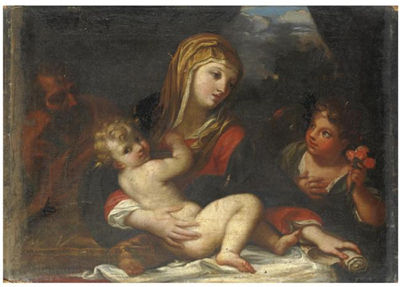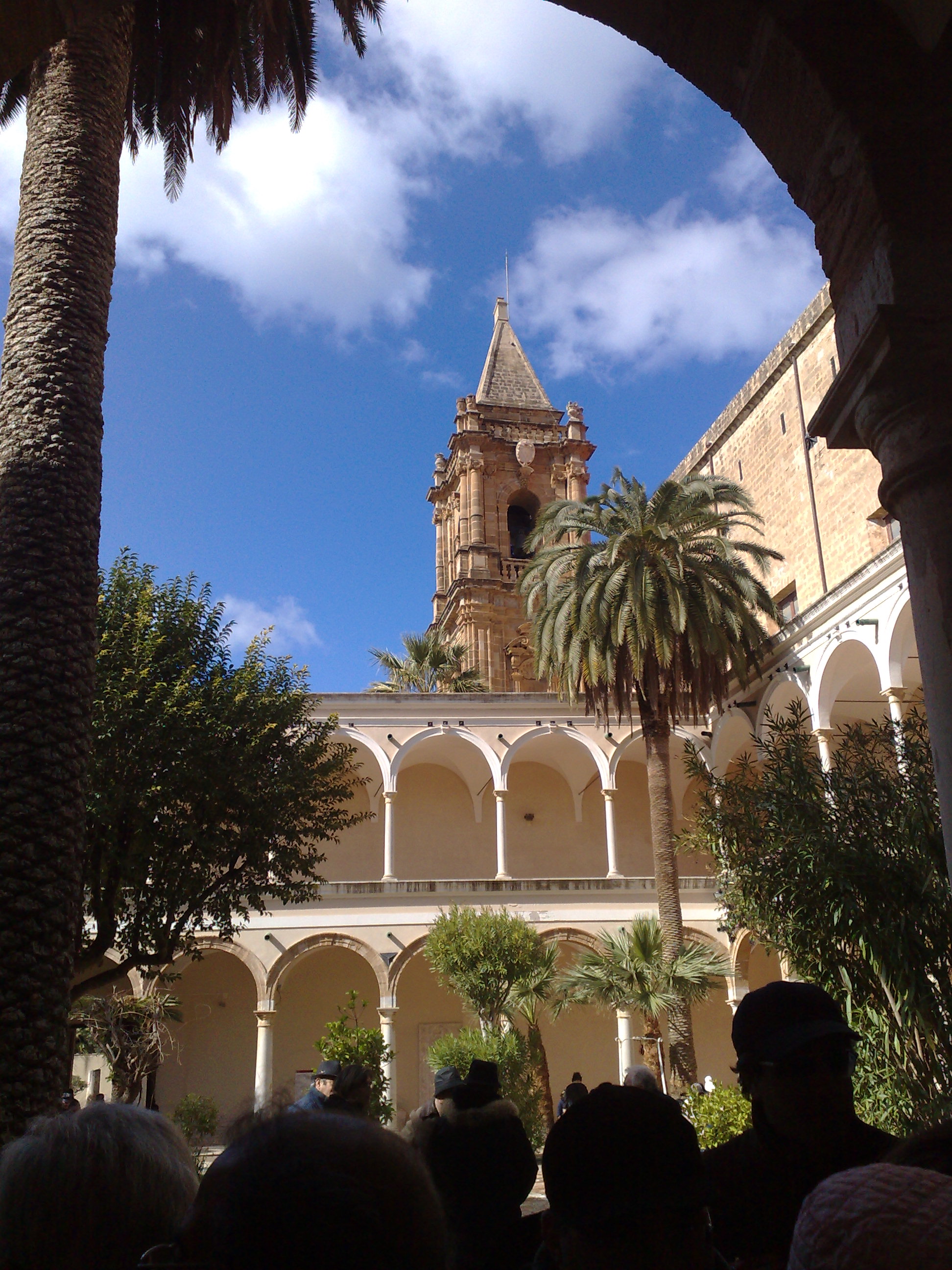|
Andrea Carreca
Andrea Carrera or Carreca (1590 – 3 February 1677) was an Italian Baroque painter mainly active in Sicily. He was born in Trapani and died in Palermo. Life He was the son of Andrea and Mattia di Vincenzo, making him nephew to the painters Vito and Giuseppe Carrera;. He studied literature and philosophy in Trapani before studying civil and canon law in Catania. He studied under his uncle Vito and also attended the studios of Pietro Novelli in Palermo and Anthony van Dyck in Rome. His panel paintings also show clear influence from Caravaggio, who was working in Palermo in 1609, whilst his art as a whole also shows borrowings from Venetian painting and Novelli. The majority of his works are in Trapani, the rest of western Sicily and Palermo – some from demolished churches are in the Museo Pepoli, such as ''Jacob's Dream'', ''Madonna and Child with St Anthony and Angels'', ''Madonna of the Rosary'' and ''St Albert the Carmelite''. In Trapani, the collegiata di San Pietro Aposto ... [...More Info...] [...Related Items...] OR: [Wikipedia] [Google] [Baidu] |
Porziuncola
Portiuncula, also spelled Porziuncola or Porzioncula, is a small Catholic church located within the Papal Basilica of Saint Mary of the Angels in Assisi in the ''frazione'' of Santa Maria degli Angeli, situated about from Assisi, Umbria (central Italy). It is the place from where the Franciscan movement started. The name Portiuncola (meaning “small portion of land”) was first mentioned in a document from 1045, now in the archives of the Assisi Cathedral. History According to a legend, whose existence can be traced back with certainty only to 1645, the little chapel of Porziuncola was erected under Pope Liberius (352-366) by hermits from the Valley of Josaphat, who had brought relics from the grave of the Blessed Virgin. The same legend relates that the chapel passed into the possession of Benedict of Nursia in 516. It was known as Our Lady of the Valley of Josaphat or of the Angels – the latter title referring, according to some, to the assumption of Mary accompanied by a ... [...More Info...] [...Related Items...] OR: [Wikipedia] [Google] [Baidu] |
17th-century Italian Painters
The 17th century lasted from January 1, 1601 ( MDCI), to December 31, 1700 ( MDCC). It falls into the early modern period of Europe and in that continent (whose impact on the world was increasing) was characterized by the Baroque cultural movement, the latter part of the Spanish Golden Age, the Dutch Golden Age, the French ''Grand Siècle'' dominated by Louis XIV, the Scientific Revolution, the world's first public company and megacorporation known as the Dutch East India Company, and according to some historians, the General Crisis. From the mid-17th century, European politics were increasingly dominated by the Kingdom of France of Louis XIV, where royal power was solidified domestically in the civil war of the Fronde. The semi-feudal territorial French nobility was weakened and subjugated to the power of an absolute monarchy through the reinvention of the Palace of Versailles from a hunting lodge to a gilded prison, in which a greatly expanded royal court could be more easily ... [...More Info...] [...Related Items...] OR: [Wikipedia] [Google] [Baidu] |
Italian Baroque Painters
Italian(s) may refer to: * Anything of, from, or related to the people of Italy over the centuries ** Italians, an ethnic group or simply a citizen of the Italian Republic or Italian Kingdom ** Italian language, a Romance language *** Regional Italian, regional variants of the Italian language ** Languages of Italy, languages and dialects spoken in Italy ** Italian culture, cultural features of Italy ** Italian cuisine, traditional foods ** Folklore of Italy, the folklore and urban legends of Italy ** Mythology of Italy, traditional religion and beliefs Other uses * Italian dressing, a vinaigrette-type salad dressing or marinade * Italian or Italian-A, alternative names for the Ping-Pong virus, an extinct computer virus See also * * * Italia (other) * Italic (other) * Italo (other) * The Italian (other) * Italian people (other) Italian people may refer to: * in terms of ethnicity: all ethnic Italians, in and outside of Italy * i ... [...More Info...] [...Related Items...] OR: [Wikipedia] [Google] [Baidu] |
People From Trapani
A person ( : people) is a being that has certain capacities or attributes such as reason, morality, consciousness or self-consciousness, and being a part of a culturally established form of social relations such as kinship, ownership of property, or legal responsibility. The defining features of personhood and, consequently, what makes a person count as a person, differ widely among cultures and contexts. In addition to the question of personhood, of what makes a being count as a person to begin with, there are further questions about personal identity and self: both about what makes any particular person that particular person instead of another, and about what makes a person at one time the same person as they were or will be at another time despite any intervening changes. The plural form "people" is often used to refer to an entire nation or ethnic group (as in "a people"), and this was the original meaning of the word; it subsequently acquired its use as a plural form of per ... [...More Info...] [...Related Items...] OR: [Wikipedia] [Google] [Baidu] |
Palermo Cathedral
Palermo Cathedral is the cathedral church of the Roman Catholic Archdiocese of Palermo, located in Palermo, Sicily, southern Italy. It is dedicated to the Assumption of the Virgin Mary. As an architectural complex, it is characterized by the presence of different styles, due to a long history of additions, alterations and restorations, the last of which occurred in the 18th century. History The church was erected in 1185 by Walter Ophamil, the Norman archbishop of Palermo and King William II of Sicily, William II's minister, on the area of an earlier Byzantine basilica. By all accounts this earlier church was founded by Pope Gregory I and was later turned into a mosque by the Saracens after their conquest of the city in the 9th century. Ophamil is buried in a sarcophagus in the church's crypt. The medieval edifice had a basilica plan with three apses, of which only some minor architectural elements survive today. The upper orders of the corner towers were built between the 14 ... [...More Info...] [...Related Items...] OR: [Wikipedia] [Google] [Baidu] |
Sclafani Bagni
Sclafani Bagni ( Sicilian: ''Sclàfani Bagni'') is a ''comune'' (municipality) in the Metropolitan City of Palermo in the Italian region Sicily, located about southeast of Palermo. Geography Sclafani Bagni borders the following municipalities: Alia, Aliminusa, Caccamo, Caltavuturo, Castronovo di Sicilia, Cerda, Montemaggiore Belsito, Polizzi Generosa, Scillato, Valledolmo, Vallelunga Pratameno Vallelunga Pratameno ( Sicilian: ''Vaddilonga'') is a ''comune'' (municipality) in the Province of Caltanissetta in the Italian region Sicily, located about southeast of Palermo and about northwest of Caltanissetta. Vallelunga Pratameno borde .... Main sights *Mother Church of ''Santa Maria Assunta''. Of medieval origins, it was renewed in the 14th and 17th century. It houses paintings from the 16th and 17th centuries. *Churches of St. Philip and St. James, both first mentioned in 1573. *Remains of the medieval castle. References External links Official website Municipalit ... [...More Info...] [...Related Items...] OR: [Wikipedia] [Google] [Baidu] |
Giacinto Calandrucci
Giacinto Calandrucci (Palermo 20 April 1646 – 22 February 1707, Palermo) was an Italian painter of the Baroque period. Originally from Palermo, he moved to Rome with his fellow Palermitan painter and engraver Pietro del Pò. Like many painters in Rome in his day, then entered the large and prolific studio of Carlo Maratta. He afterwards worked under Giuseppe Passeri. In the 1680s Calandrucci completed decorative frescoes of the ''Four Seasons'' in the Palazzo Lante; mythological frescoes in the gallery of the Palazzo Muti Papazzurri; the decoration of the gallery of the Palazzo Strozzi-Besso; and a ceiling fresco, and the ''Sacrifice of Ceres'' in the papal Villa Falconieri at Frascati. He also painted idyllic pastoral scenes, among them two pictures at Burghley House, Stamford, England. He also painted in Rome two works for the main altar and the Cimini Chapel in the church of Sant'Antonio dei Portoghesi, a ''Virgin and Child with St Anne and Saints'' in frescoes an ... [...More Info...] [...Related Items...] OR: [Wikipedia] [Google] [Baidu] |
Diocesan Museum Of Palermo
The Diocesan Museum of Palermo (Italian - ''MUDIPA'' or ''Museo diocesano di Palermo'') is a museum of religious art in Palermo on Sicily, housed in a number of rooms in the Palazzo Arcivescovile opposite Palermo Cathedral. History It was founded in 1927 by cardinal Alessandro Lualdi, Archbishop of Palermo (1904–1927). Layout Room I This houses the welcome desk as well as artworks from the Norman and Swabian eras. Room II - ''Sala dei fondi oro'' This contains works from the 14th and 15th centuries as well as imported 14th century Pisa works: * 1171, ''Madonna of the Pearl'', tempera on panel, anonymous, from Santa Maria del Cancelliere church * 13th century, ''Madonna della Spersa'', tempera on parchment mounted on panel, anonymous, from San Nicolò all'Albergheria church * 1388, ''Roll of Dead Brothers'', tempera on panel, Antonio Veneziano (painter), Antonio Veneziano, commissioned by the Confraternita dei Disciplinanti, from San Nicolò lo Reale church * 1419, ''Cor ... [...More Info...] [...Related Items...] OR: [Wikipedia] [Google] [Baidu] |
Museo Regionale Agostino Pepoli
The Museo regionale Agostino Pepoli is an art, archaeology and local history museum in Trapani. It is one of the most important museums in Sicily. Established in 1906-1908 as the civic museum by count Agostino Pepoli and initially based on the private collection of count Sieri Pepoli and Neapolitan paintings donated by general Giovanbattista Fardella, it is based in a former 14th century Carmelite monastery next to the Basilica-santuario di Maria Santissima Annunziata. In 1921 it acquired count Francesco Hernandez di Erice's collection of cribs, ceramics and archaeological objects In 1925 it became the ''Regio museo'', after the Second World War it became a national museum and finally in 1977 (when responsibility for cultural assets was devolved to the Italian regions) it was again renamed, this time the museum of the Sicilian Region. In the meantime its displays had been redesigned in the 1960s by the architect Franco Minissi, who for his work won the 1969 IN.ARCH., a region ... [...More Info...] [...Related Items...] OR: [Wikipedia] [Google] [Baidu] |
Basilica-santuario Di Maria Santissima Annunziata
The Basilica-Sanctuary of Maria Santissima Annunziata (also called "Madonna of Trapani") is a Roman Catholic church and minor basilica, dedicated to Our Lady of Mount Carmel in Trapani, in Sicily. It is included in the Roman Catholic Diocese of Trapani. The basilica Was originally built by the Carmelite Order in 1315–1332 and rebuilt in 1760. The church houses the skull of Saint Albert of Trapani in a silver statue crafted in the 18th century, and the relics of Clement of Ancyra. Statue of the Madonna It houses a marble statue of the Madonna of Trapani (Our Lady with Child), which might be the work of Nino Pisano "Euclid", panel from Museo_dell'Opera_del_Duomo_(Florence)">Museo_dell'Opera_del_Duomo,_ Museo_dell'Opera_del_Duomo,_Florence">Museo_dell'Opera_del_Duomo_(Florence)">Museo_dell'Opera_del_Duomo,_Florence_">Florence.html"_;"title="Museo_dell'Opera_ .... The statue is life-size, weighs 12 tons and is 165 cm high. To her left she is holding the baby Jesus. Pope Cl ... [...More Info...] [...Related Items...] OR: [Wikipedia] [Google] [Baidu] |



_1938.jpg)



